Spring Risotto with Asparagus & Peas
This post may contain affiliate links. Read my full disclosure policy.
This creamy risotto with asparagus and peas makes a lovely starter, side dish, or vegetarian main course for spring.
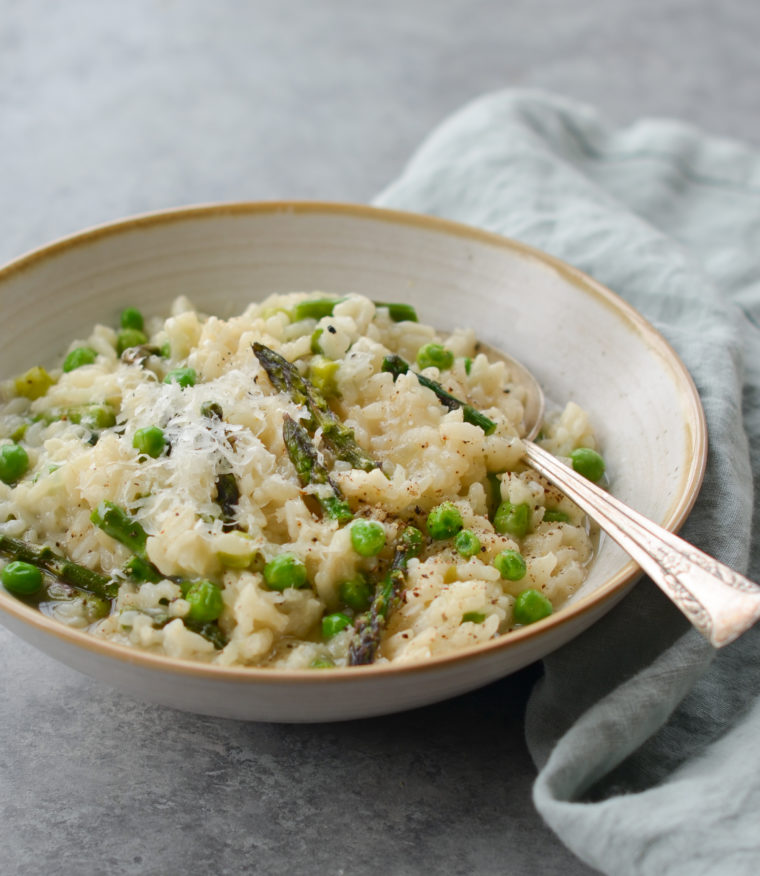
Comforting to eat — and comforting to make, in a mindless, repetitive sort of way — risotto is a northern Italian rice dish cooked gently until it reaches a creamy consistency. Most people think of it as a restaurant-style dish, but it’s actually quite simple to make with just a few ingredients. The only thing to keep in mind is that it requires frequent stirring, so you need to stay close to the stove for 25 minutes while it cooks.
This spring risotto calls for seasonal vegetables but there’s lots of room for creativity and improvisation. Don’t feel like asparagus? Substitute zucchini or mushrooms. Going vegetarian? Replace the chicken broth with vegetable broth. Want to fancy it up? Stir in some fresh herbs at the end. You really can’t go wrong as long as you stick to the basic formula. Serve this spring risotto as a meatless main course or as a side to a simply cooked main dish, like pan-seared salmon or perfectly grilled chicken breasts.
How To Make Spring Risotto with Asparagus & Peas
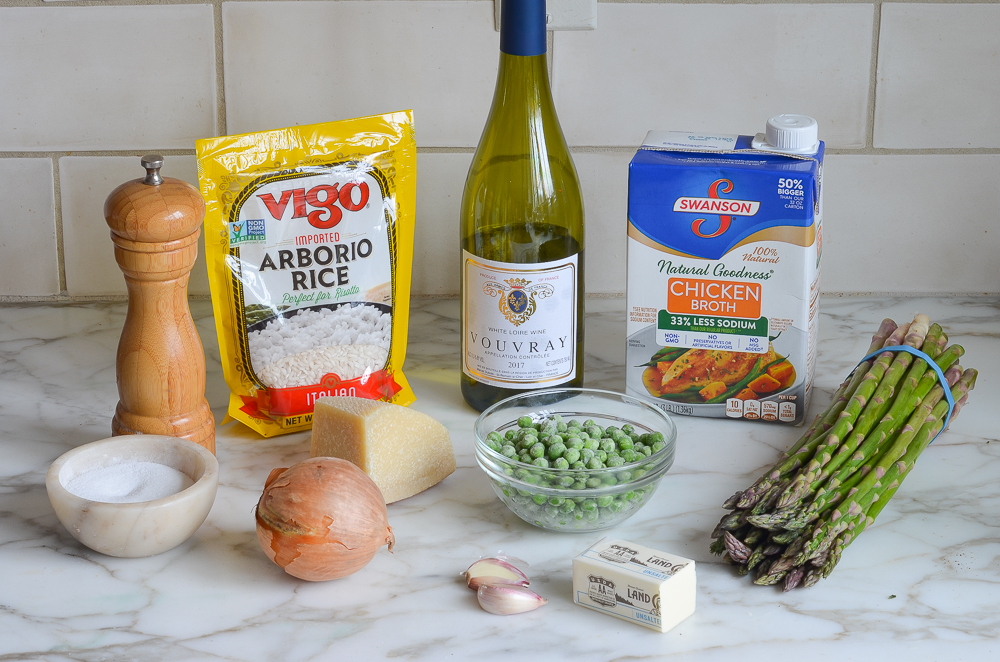
Before we get to the step-by-step instructions, a few words about the ingredients:
- All risotto recipes begin with Arborio rice, a short-grained, high-starch Italian rice that becomes creamy and slightly chewy when cooked. You can find it in the rice section of most supermarkets.
- White wine is a key ingredient in risotto, as it adds nice depth of flavor. However, if you’d prefer not use it, replace it with more broth and add a squeeze of lemon at the end.
- It’s important to use low-sodium broth when making risotto. The broth reduces while it cooks, intensifying the saltiness.
Step-by Step Instructions
The first step to cooking risotto is to bring your broth to a simmer. It’s important that the broth is hot before you add it to the rice, as cold broth will cool the pan down and slow the cooking process.
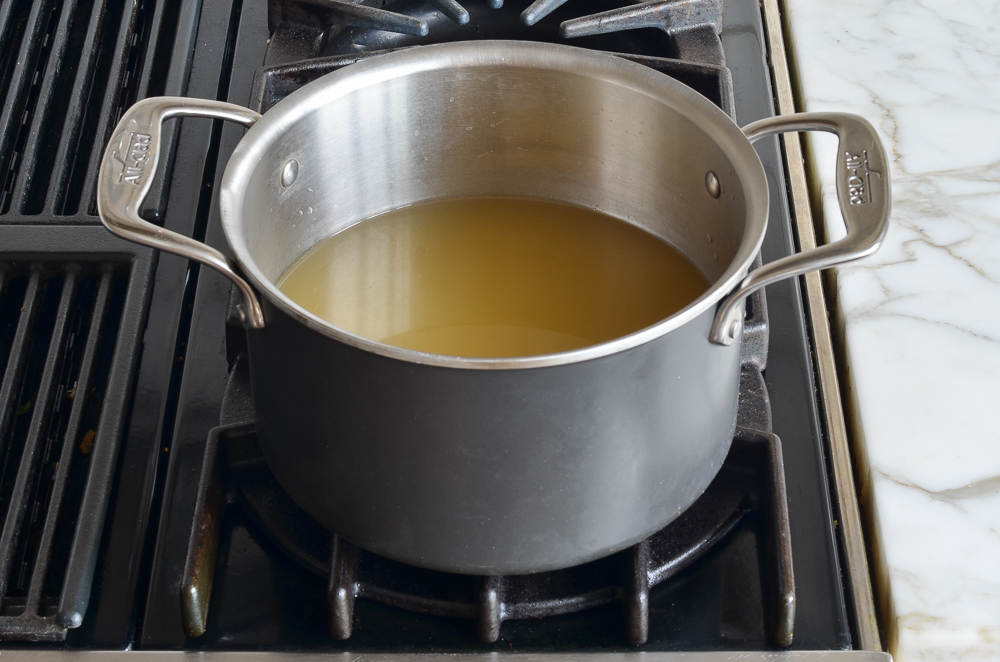
While the broth heats up, melt the butter in a large pot or Dutch oven (it’s important to use a large cooking vessel, as the rice will increase in volume when cooked). Add the asparagus and cook until tender-crisp, a few minutes.
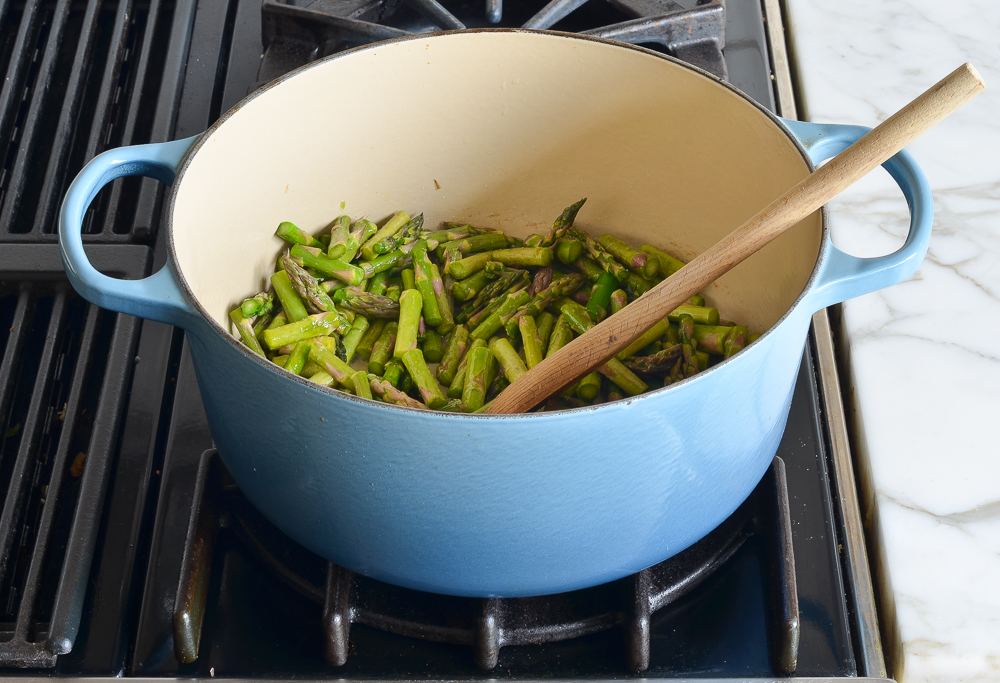
Add the peas and cook for 1 minute more, until they are defrosted.
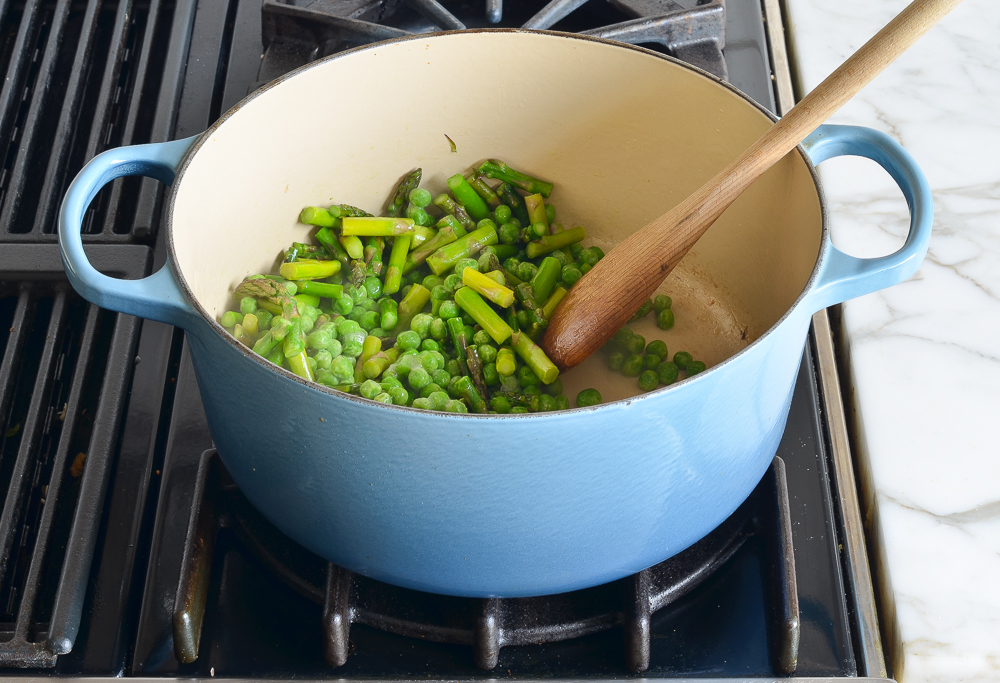
Transfer the vegetables to a plate and set aside. You’ll add them back to the risotto at the very end. Cooking the vegetables first ensures that they don’t overcook.
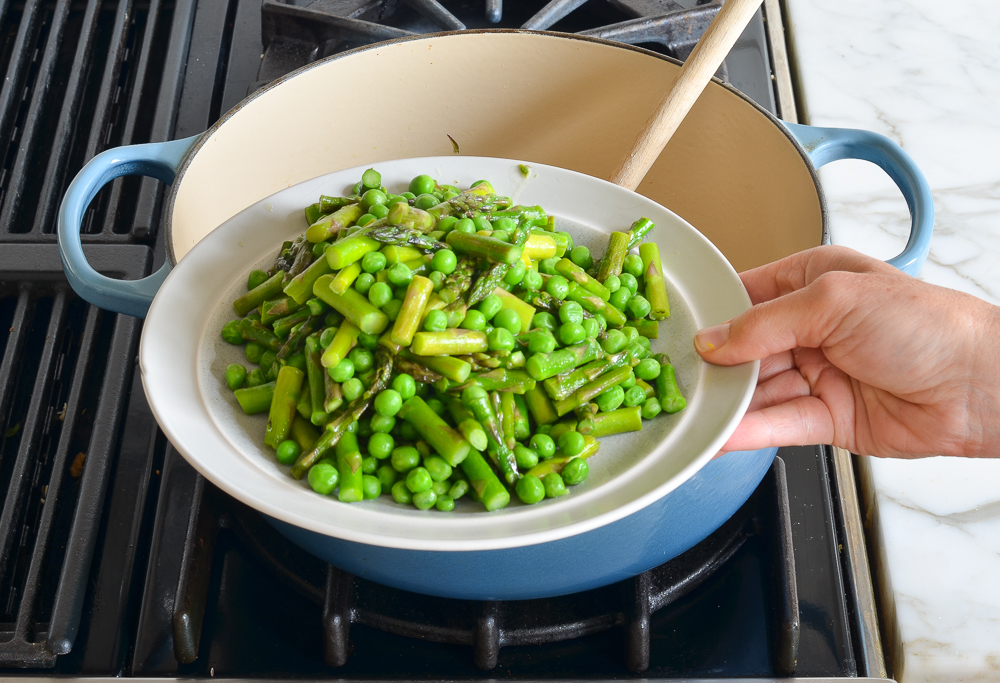
In the same pot over medium-low heat, melt 2 tablespoons of the butter and add the onions.
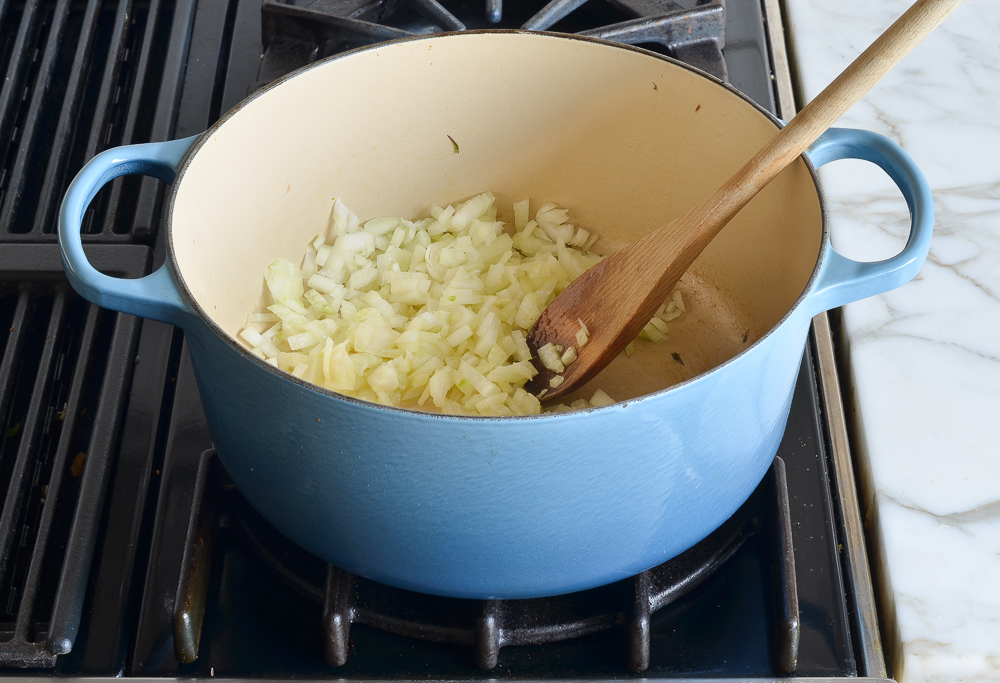
Cook, stirring frequently, until translucent, 2 to 3 minutes. Then, add the garlic and cook for 1 minute more. Do not brown.
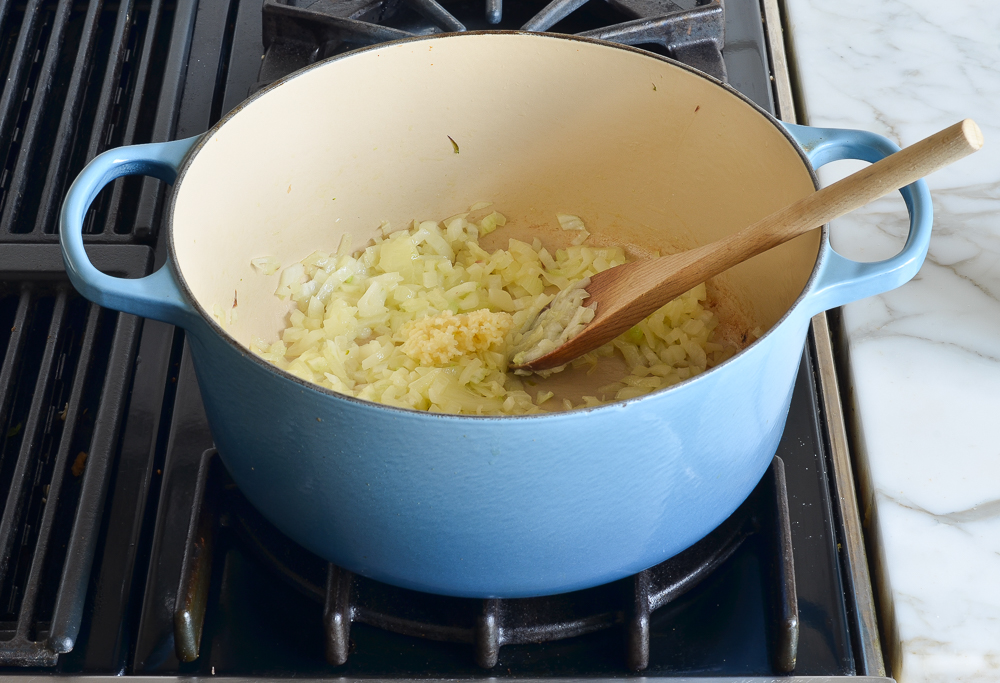
Add the Arborio rice to the onions and garlic.
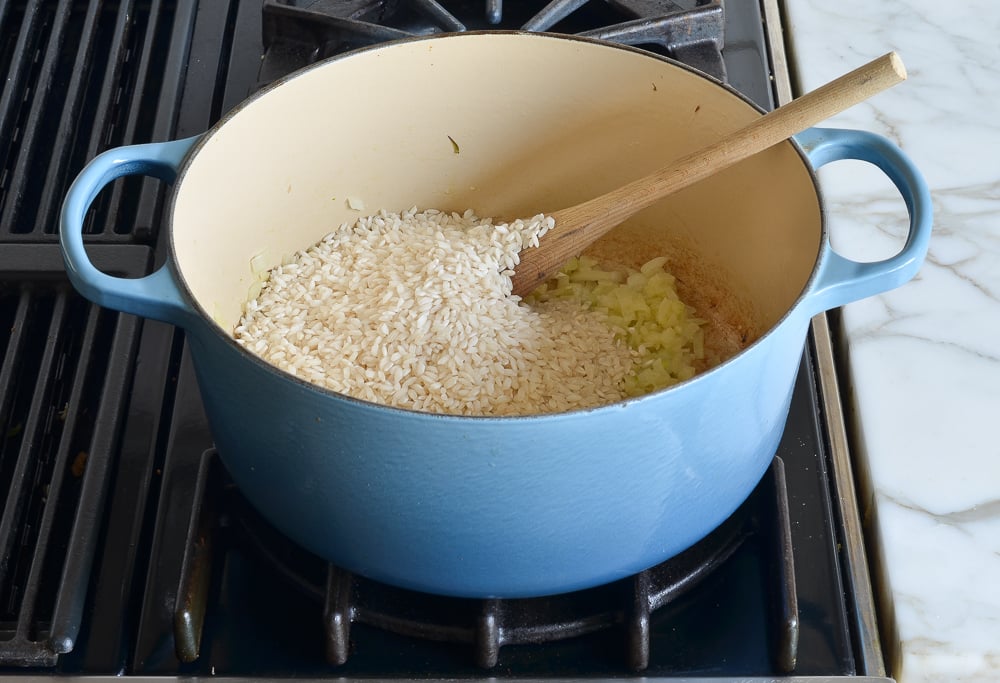
Cook, stirring constantly, until glossy and translucent around the edges, about 3 minutes. This step of toasting the rice in fat adds depth of flavor and also prevents the grains from becoming mushy during the cooking process.
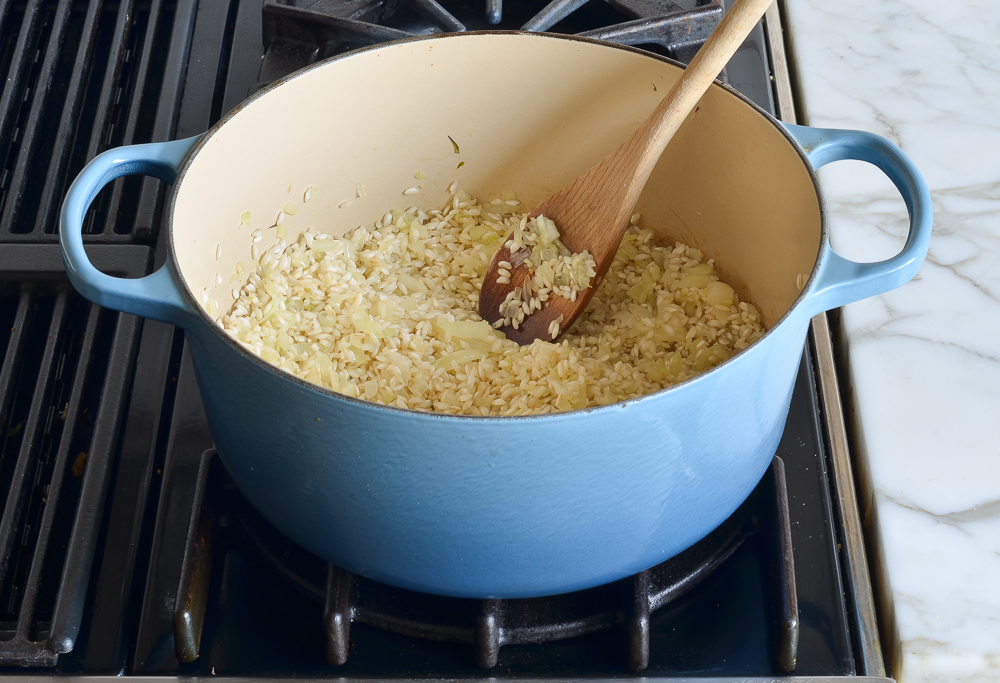
Add the wine and cook until completely absorbed, about 1 minute.
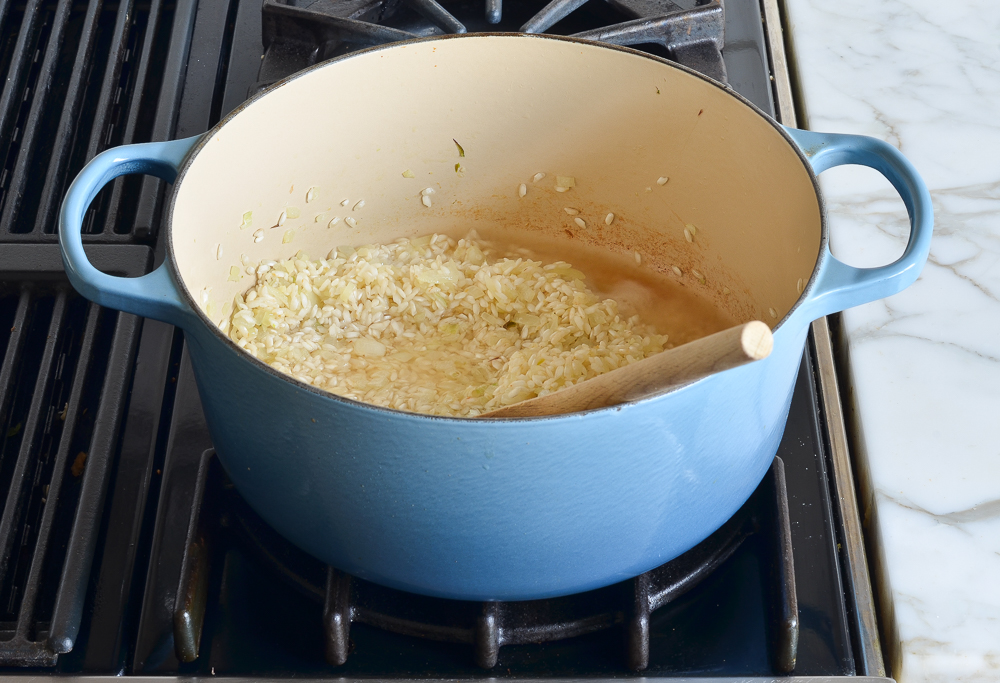
Ladle about 1 cup of the simmering broth into the rice.
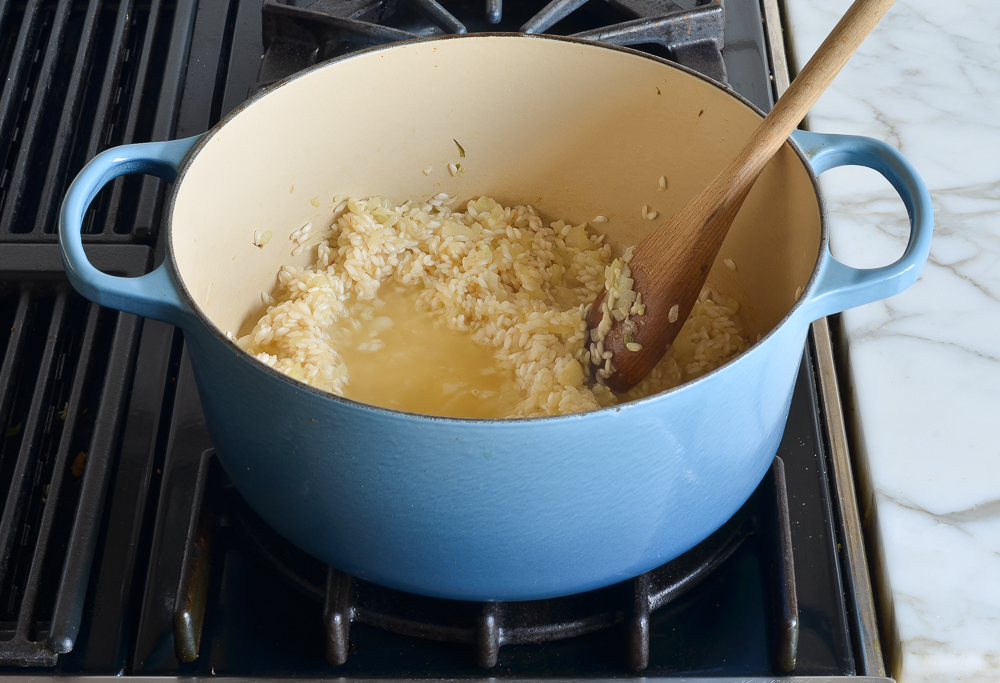
Cook, stirring occasionally, until absorbed. Continue adding the broth, 1 cup at a time and stirring until it is absorbed, until the rice is tender, about 25 minutes. You don’t need to stir constantly; just check on it every few minutes to stir and prevent sticking. You’ll know it’s done when the rice al dente — just cooked, still with a little bite to it.
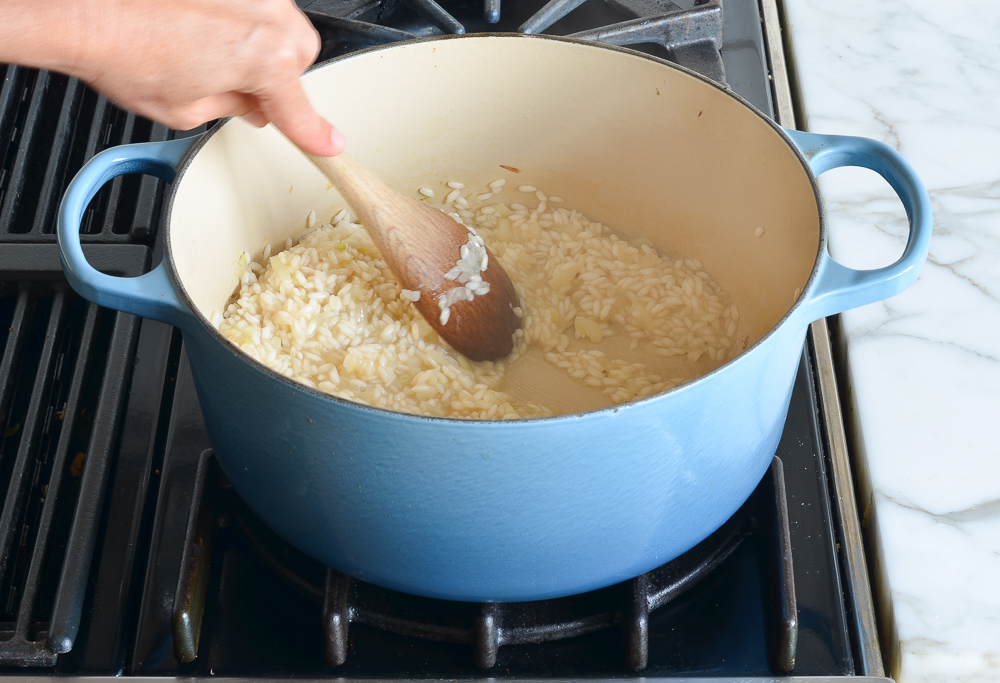 Add the reserved vegetables, Parmigiano-Reggiano, and remaining tablespoon of butter to the risotto.
Add the reserved vegetables, Parmigiano-Reggiano, and remaining tablespoon of butter to the risotto.
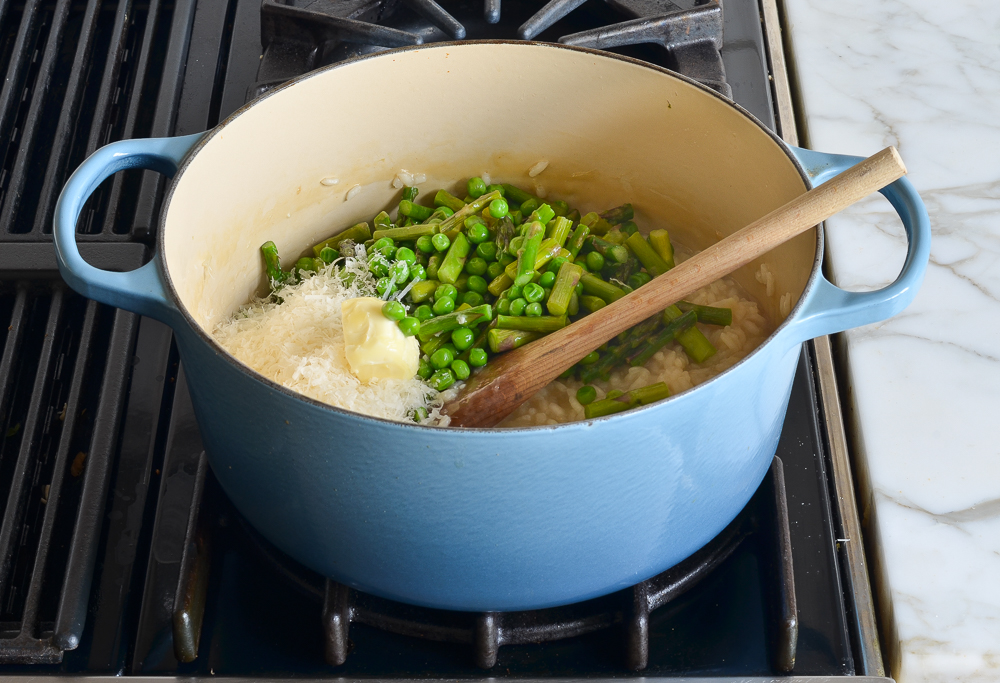
Stir, then taste and adjust seasoning with salt and pepper, if necessary. If the risotto is too thick, thin it with a bit of milk. Spoon into bowls and serve with more cheese.
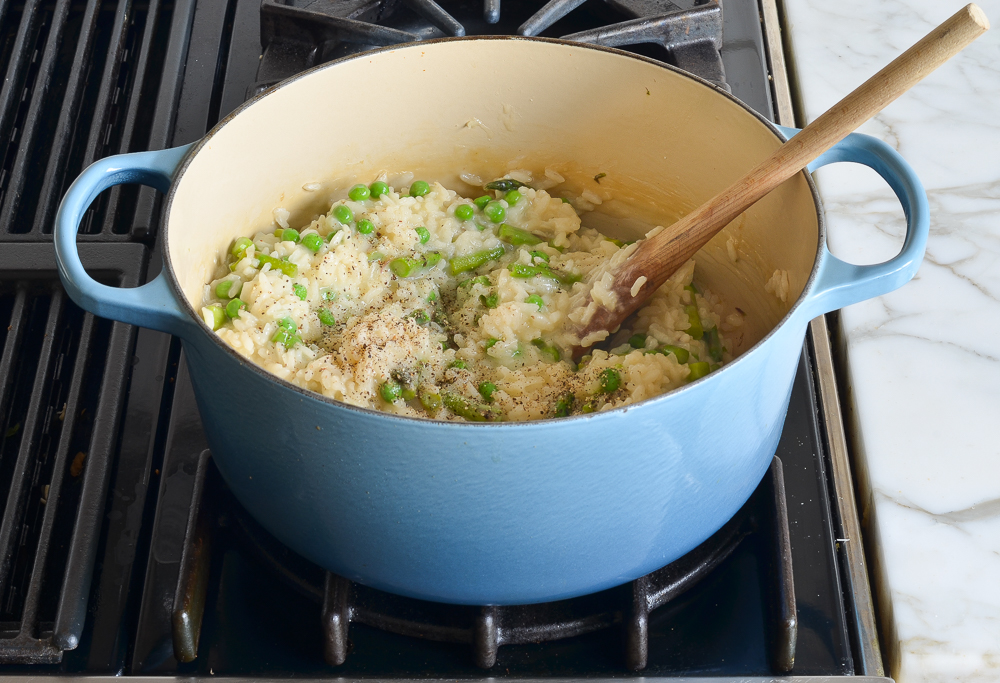
If you have leftover risotto, I highly recommend making risotto cakes. They are quite possibly even better than the actual risotto! You don’t need a recipe: simply mix the leftover cold risotto with a generous handful of shredded cheese. Use a cheese that melts well, such as fontina, Cheddar, Gruyère, or mozzarella. Scoop up about 1/3 cup of the risotto at a time and shape into patties about 3/4 inch thick and 3 inches wide. Coat the risotto cakes in panko, then fry in olive oil over medium heat until golden and crisp, about 3 minutes per side.
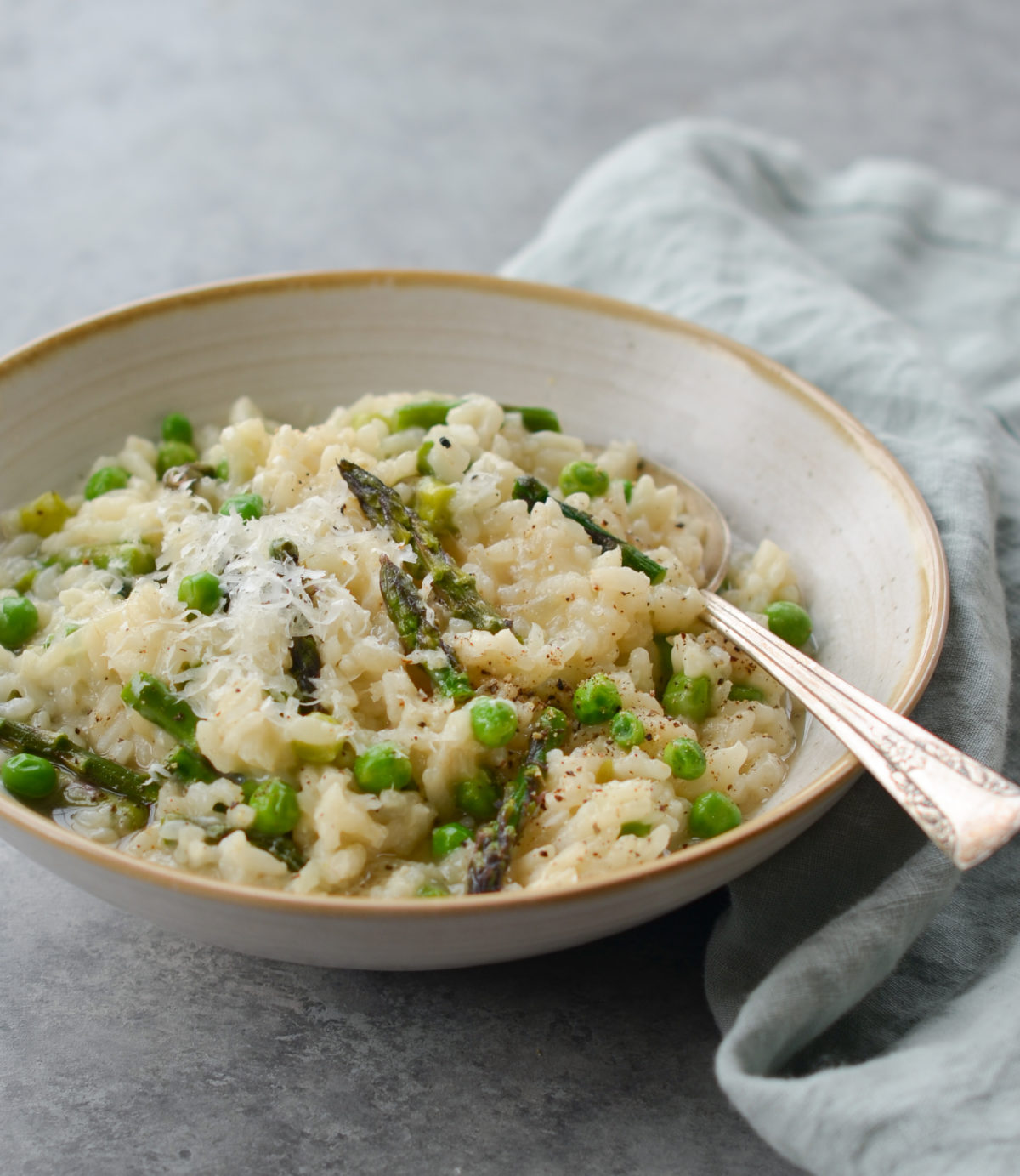
You may also like
- Pea Soup with Basil
- Orzo Risotto with Shrimp, Peas & Bacon
- Spinach Quiche
- Ratatouille
- Green Pea & Asparagus Soup with Feta, Mint & Pita Croutons
Spring Risotto with Asparagus & Peas
This creamy risotto with asparagus and peas makes a lovely starter, side dish, or vegetarian main course for spring.
Ingredients
- 6 cups low-sodium chicken broth
- 4 tablespoons unsalted butter, divided
- 1 bunch asparagus, preferably thin, trimmed and cut into 1-in pieces
- ¼ teaspoon salt
- Freshly ground black pepper
- 1 cup frozen peas
- 1 medium yellow onion, finely chopped
- 2 cloves garlic, minced
- 1½ cups Arborio rice
- ½ cup dry white wine
- ½ cup grated Parmigiano-Reggiano, plus more for serving
Instructions
- In a medium pot, bring the broth to a simmer.
- Meanwhile, in a large pot or Dutch oven, melt 1 tablespoon of the butter over medium-low heat. Add the asparagus, salt, and a few grinds of pepper. Cook, stirring frequently, until the asparagus is tender-crisp, 2 to 4 minutes, depending on the thickness of the asparagus. Add the peas and continue cooking until the peas are defrosted, about 1 minute. Transfer the vegetables to a plate and set aside.
- In the same pot over medium-low heat, melt 2 tablespoons of the butter. Add the onions and cook, stirring frequently, until translucent, 2 to 3 minutes. Add the garlic and cook for 1 minute more. Do not brown. Add the rice and cook, stirring constantly, until glossy and translucent around the edges, about 2 minutes. Add the wine and cook until completely absorbed, about 1 minute. Ladle about 1 cup of the simmering broth into the rice and cook, stirring occasionally, until absorbed. Continue adding the broth, 1 cup at a time and stirring frequently until it is absorbed, until the rice is al dente and creamy, about 25 minutes. (Be careful not to get distracted while the rice is cooking; while it doesn’t require a lot of skill, it does require you to keep a close eye on it to prevent sticking.)
- Stir in the reserved vegetables, Parmigiano-Reggiano, and remaining tablespoon of butter into the risotto. Taste and adjust seasoning with salt and pepper, if necessary. If the risotto is too thick, thin it with a bit of milk. Spoon the risotto into bowls and serve. Pass the Parmigiano-Reggiano at the table.
Nutrition Information
Powered by ![]()
- Per serving (8 servings)
- Calories: 277
- Fat: 9 g
- Saturated fat: 5 g
- Carbohydrates: 37 g
- Sugar: 2 g
- Fiber: 3 g
- Protein: 10 g
- Sodium: 245 mg
- Cholesterol: 20 mg
This website is written and produced for informational purposes only. I am not a certified nutritionist and the nutritional data on this site has not been evaluated or approved by a nutritionist or the Food and Drug Administration. Nutritional information is offered as a courtesy and should not be construed as a guarantee. The data is calculated through an online nutritional calculator, Edamam.com. Although I do my best to provide accurate nutritional information, these figures should be considered estimates only. Varying factors such as product types or brands purchased, natural fluctuations in fresh produce, and the way ingredients are processed change the effective nutritional information in any given recipe. Furthermore, different online calculators provide different results depending on their own nutrition fact sources and algorithms. To obtain the most accurate nutritional information in a given recipe, you should calculate the nutritional information with the actual ingredients used in your recipe, using your preferred nutrition calculator.

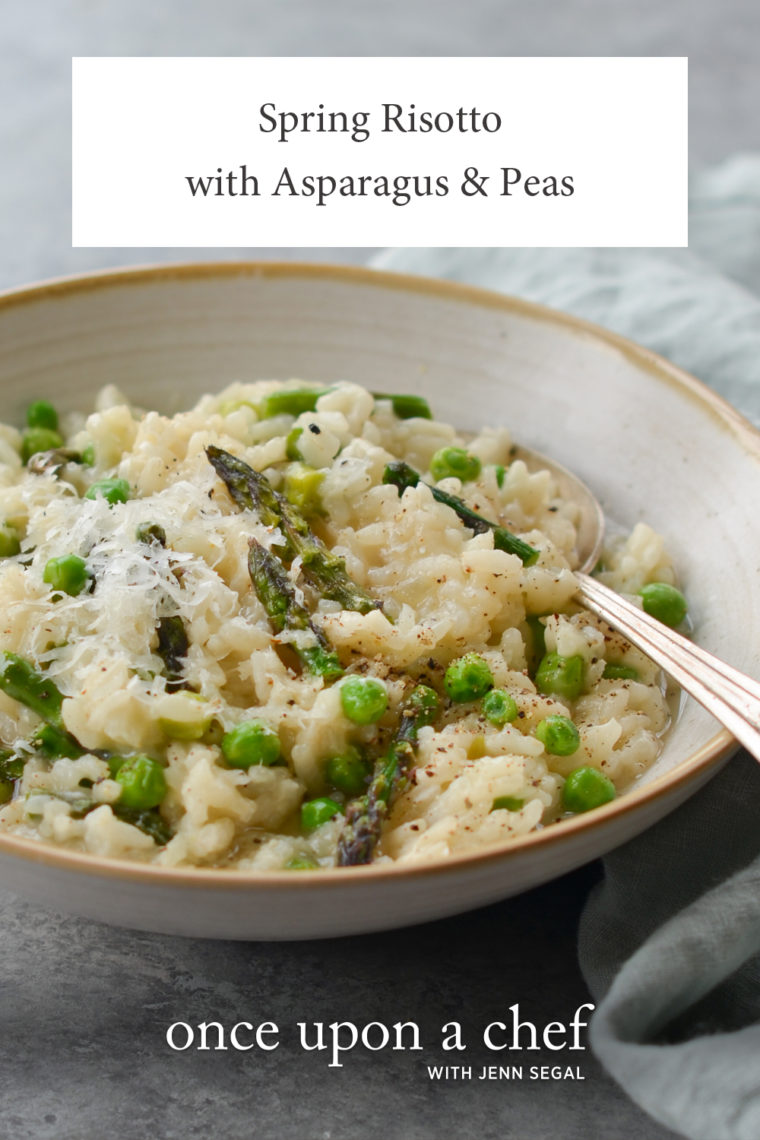
Delicious! Big hit with my family. Used vegetable broth because my daughter is a vegetarian. It worked just fine instead of the chicken broth.
This recipe is very good. I was happy that the vegetables – asparagus especially was well seasoned. My husband is Italian and usually I leave him to do the risotto as I did it a few years ago and I thought he does it much better. He was horrified when I said I was adding in onions and garlic – it’s one or the other traditionally – apparently ?? But when he tasted it he was quite impressed. I was a bit worried about the quantity of broth so I didn’t use all of it but maybe 2/3rds /3/4ths which may have affected the flavour but next time I will fully follow the recipe.
This was very delicious. Took me closer to 45 minutes for all the broth to absorb, and I also added the zest of a lemon and the juice of half a lemon at the end when I stirred in the vegetables, plus a bit of tarragon from my garden. I also used fresh shelled peas instead of frozen, and just stirred them in for the last minute during the asparagus cooking stage, so they maintained a bit of a bite. DELICIOUS
I am not normally a fan of risotto but this was amazing! Served it last night to rave reviews from my family full of food critics. Thank you for sharing it.
Hi Jen,
This recipe looks great and I am planning on trying it soon. I would like to serve it with a light salad and shrimp (on the BBQ preferably). What flavours for the shrimp marinade/rub would you recommend to go with this risotto?
Thanks in advance!
Hi Bry, this would pair nicely with a shrimp that is flavorful but doesn’t compete too much with the flavors in the risotto. This one would work well. Hope you enjoy whatever you decide on!
Great recipe! First risotto I ever made so am excited it turned out. Added mushrooms instead of asparagus and no wine and it was delicious.
A delicious risotto! I added sliced zucchini with the asparagus and later added chopped fresh mint just before serving. I’ve turned the leftovers into patties by rolling the risotto in flour, then egg and then panko crumbs before pan frying. Also yum! Thanks once again, Jen! ❤️
This is one of the best risottos I have ever made, although I had to make some substitutions due to the fact that I am being frugal about any shopping trips. So, I used cream sherry in place of white wine, and instead of the garlic cloves and onion, I used 1/2 cup of green garlic and 1/2 cup of onion. Then finally I realized I had no Parmesan so I used Pecorino Romano. Sooo delicious!!! What a great recipe that allows for such substitutions and is still wonderfully good! Thanks so much!
I have loved every recipe I have ever tried of yours.
I don’t usually keep white wine on hand. Is it something that will go bad in a few days? Or is there a substitute you would recommend?
Thank you,
Hi Lena, An open bottle of white wine should be good for about 1 week (although I often let it go for longer) but it’s fine to use more broth instead of the wine; just add a squeeze of lemon at the end. Hope you enjoy!
Fantastic rissotto, simply delishious.
Actually I just realized I would have to leave out the Parmesan or use an alternative there too. Allergy to dairy.
I’m not sure of a great dairy-free alternative to Parm but it looks like you can create your own version. I haven’t tried it, but this recipe looks promising. Hope that helps!